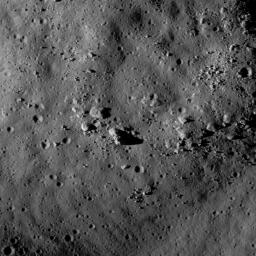
|
Hummocks and Blocks and Craters
- Click the image above for a larger view
- Full-Res JPEG (1000 x 1000) (170.8 kB)
- Full-Res TIFF (1000 x 1000) (1.0 MB)
Caption:
Hummocks and blocks on the ejecta blanket of Tsiolkovskiy crater. Image width is 830 meters.
The farside crater Tsiolkovskiy is one of the most spectacular and unique geologic features on the Moon. A prime candidate for one of the later Apollo flights, Tsiolkovskiy is now one of the highest-priority sites for future human lunar exploration. Identified in the first image of the farside, and named after visionary space pioneer Konstantin Tsiolkovskiy, Tsiolkovskiy (185 km diameter) has a an irregular (non-circular) shape, a central peak, and is incompletely filled with mare basalt.
Background Info:
NASA's Goddard Space Flight Center built and manages the mission for the Exploration Systems Mission Directorate at NASA Headquarters in Washington. The Lunar Reconnaissance Orbiter Camera was designed to acquire data for landing site certification and to conduct polar illumination studies and global mapping. Operated by Arizona State University, the LROC facility is part of the School of Earth and Space Exploration (SESE). LROC consists of a pair of narrow-angle cameras (NAC) and a single wide-angle camera (WAC). The mission is expected to return over 70 terabytes of image data.
Cataloging Keywords:
| Name | Value | Additional Values |
|---|---|---|
| Target | Moon | |
| System | Earth | |
| Target Type | Satellite | |
| Mission | Lunar Reconnaissance Orbiter (LRO) | |
| Instrument Host | Lunar Reconnaissance Orbiter | |
| Host Type | Orbiter | |
| Instrument | Lunar Reconnaissance Orbiter Camera (NAC) | |
| Detector | Narrow Angle Camera (NAC), Wide Angle Camera (WAC) | |
| Extra Keywords | Crater, Grayscale | |
| Acquisition Date | ||
| Release Date | 2009-08-04 | |
| Date in Caption | ||
| Image Credit | NASA/GSFC/Arizona State University | |
| Source | photojournal.jpl.nasa.gov/catalog/PIA12894 | |
| Identifier | PIA12894 | |
